-

"hibiscustour", three separate sites -

Curiosity. Things, drôle, science, société.. -

Ideas perso. Household, Practical life, D.I.Y, Computering.. -
Islands and lagoons New Caledonia, Polynesia (part).

|
|
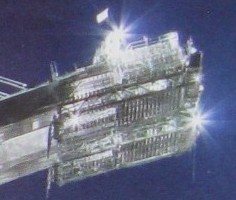
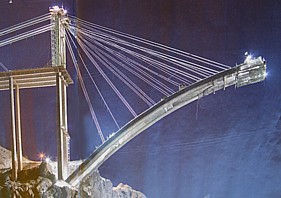
|

Dutch MX3D has teamed up with giant Autodesk Software to build a 3 merged bridge in 3D processing" We see here two white controlled robots sliding up to the bridge (in 1), that melt metal rods on " drops of metal already deposited and solidified. Thus advances the bridge, with in 3D, its delicate designs of wrought iron ! |
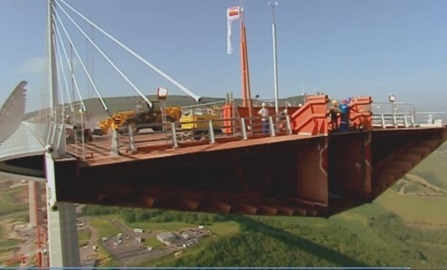 Big bridges are seemingly made of concrete but are in fact metallic and hollow ! the concrete is in siding or in reinforcement for the piles, which also include a strong metal frame.
The inside of the structure was once painted but now, it is not. A moisture controlled air circulates now inside, so that the rust is stabilized. We gain in maintenance, weight and safety.
Big bridges are seemingly made of concrete but are in fact metallic and hollow ! the concrete is in siding or in reinforcement for the piles, which also include a strong metal frame.
The inside of the structure was once painted but now, it is not. A moisture controlled air circulates now inside, so that the rust is stabilized. We gain in maintenance, weight and safety.
Central link of an axis that must connect the North Sea to the Mediterranean, the longest railway tunnel in the world is Swiss.
It replaces an old tunnel on Mount St Gothard and eleven years work were necessary to complete it on October 15, 2010 for commissioning scheduled in 2017.
Its two tubes tart from Erstfeld and end in Bodio, 57 kilometers. The Seikan, Japan, is 53.9 km (1988).
That of Mt Cenis, France, expected in 2023, will have 53 km
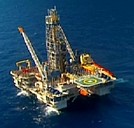 We know how to go very deep underground or underwater (several thousand meters), but we can hardly imagine the complexity of current drilling techniques. The review " Research " unveils a part of it, starting with the drilling of soil analysis, measurements (associated sensors), injections, rejection of excavated material, etc. Thus, it is possible to drill vertically up to 2000 meters, then to 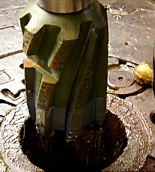 Opposite, photo of a Drill Head
Opposite, photo of a Drill Head
How is it possible ? by the control of a motor which decenters the drill head; this one then at an angle. We control the decentering to correct the trajectory permanently. |
To exploit reserves covering several kilometers on firm ground, a network of wells is installed. At sea, a platform operates many wells and then manages all these wells, up to 35 for Perdido, the last of the Gulf of Mexico.
The diagram shows the course of drilling under water, then in the basement. The green line marks the waterline of the platform. & Nbsp;
Report of "the 5" (TV).
|
Giant platform "Perdido"
Several billion euros, 18,000 tons (bridge of 9,000 tons). The first & quot; floating & quot; to rest only on a single float, ballasted at its base of 13,000 tons of iron ore.
Explosion-proof partitions separate the housing part. Maximum safety has been sought against fire, overturning and breaking pipes; this last point by seeking the best possible stabilization of
oscillations (waves, circular marine currents).
Report of "the 5" (TV).
|
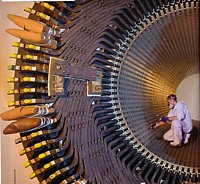
Giant alternator driven by turbine. Here this part is "the armature""". Electric current is "induced" along its copper wires, due to the rotating magnetic fields generated by the rotor, said inductor, which is spinning inside (where is the man) &Nbsp;
As we said above, The fixed part that surrounds the central rotor produces the current .
l
Hydraulic turbine room of the Three Gorges Dam (China). 15 out of 26 are produced by Alsthom.
Enclosed in the ground, they are high as a 10-storey building. The
Here, a turbine for the Vietnam.
|
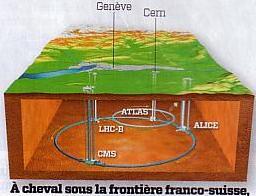 The most BIG electromagnets .
The most BIG electromagnets .
In September 2008, the largest particle accelerator in the world , the Large Hadron Collider or "LHC" is started up at CERN , on the French-Swiss border. Located at 100 meters underground and 27 km long , the LHC is the largest particle accelerator in the world. It has two tubes under a very high vacuum in which the beams of particles are sent. The beams are guided by a powerful electromagnetic field generated by some 1600 magnets . Aligned with a precision of the order of a tenth of a millimeter, each of the 1232 main magnets is 15 meters long and weighs 35 tons ! Rarely among the accelerators, the windings of these magnets are superconductors , in other words they conduct electricity without resistance, up to 13,000 amperes or loss of energy . This property only appears at very low temperatures. ADVENTUROUS. Far fewer, but 10 times heavier ! ITER |
|
|